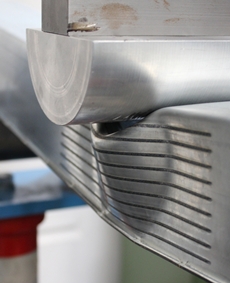Making cars that are lightweight and crash-safe
10 Aug 2013
Lightweight or crash-safe - is a trade-off for auto makers, which may see a change with the emergence of a new lightweight construction technology. The result could lead to vehicles that could be lightweight as well as better equipped to take the stress of a crash, andd of course, consume less fuel and cost less to manufacture.
 | |
| This crash test is designed to establish how much a sample component deforms under a defined bending stress. © Fraunhofer IWS |
The auto industry that has turned out ever heavier cars year on year, will now have to make vehicles that are lighter with lower fuel consumption and CO2 emissions.
If auto makers do not dramatically reduce the average CO2 emissions of their cars, they will face hefty fines. That was determined by the European Commission in a new piece of legislation.
One way to achieve a major cut in fuel consumption is through lightweight construction - in other words, cars have to slim down. But this must not jeopardize the safety of vehicle occupants - and that is a big challenge for auto designers, who are faced with the task of fulfilling these contrary requirements. Vehicle bodies until now have consisted largely of a homogenous sheet steel structure with constant component sheet thicknesses.
Components that are subject to particularly strong local stresses are often oversized, because the wall strength has to be designed to withstand the highest local stress point. This means that the sheet thickness is greater than needed in areas that are subject to less stress, making components unnecessarily heavy. Moreover, automakers use lots of expensive, high-strength steel sheets. At present, then, compromises are constantly being made between component weight, component cost, and crash safety.
Now researchers at the Fraunhofer Institute for Material and Beam Technology (IWS) in Dresden have developed a lightweight construction technology that makes it possible to reduce vehicle weight while ensuring adequate crash safety.
''Safety and lightweight construction need not contradict each other,'' says Markus Wagner, a scientist at the IWS. In order to match the characteristics of body components more precisely to the stresses that act on them, the engineer and his colleagues are pursuing an exciting new approach called ''local laser reinforcement''.
This approach involves using low-cost, low-strength steel sheets with minimized wall thickness and reinforcing them locally only in those areas that are subject to strong stresses. To do this, the experts guide a focused laser beam over the surface of the unprocessed sheet. The zones treated in this way heat up or even begin to melt, before solidifying again.
The heat dissipates quickly into the adjacent cold material, causing the track to cool down rapidly. This produces hard phases and the material is significantly strengthened. ''We obtain strengths of up to 1,500 MPa (megapascals). That's roughly twice the strength of the unreinforced basic material,'' says Wagner. ''This enables us to optimize the weights and stresses above all in the design of the front and rear bumper beams, the B-pillar, and various stiffeners.''
Components that bend only half as much
Crash stresses create complex high-speed deformations in components. By means of local laser reinforcement, scientists are striving to obtain greater resistance to deformation. The less the car body part bends, the greater protection the driver has. At the same time, failure behavior can be influenced by predetermining the position of the first plastic deformation.
For this to work, the researchers have to determine the optimum position and geometry of the reinforcement tracks. Should the tracks be pointed? Slanted? Should they run lengthwise? What should the material's composition be to optimise how difficult it is to deform the reinforcement zone? The researchers can find the answers to all these questions via simulation tests on the computer. ''With our simulations, we are able to model field tests. The results obtained from trials and simulations deviate just a few millimeters from each other,'' says Wagner.
With the aid of numerical simulation, the scientist and his team have developed a crash-optimized track design for bending stress such as might arise when a car collides head-on with a tree or is hit by another car from the side. The track design was transferred onto real components using a laser. ''We managed to halve the deflection of a locally laser reinforced pipe profile compared to the reference part, even though we locally reinforced only three percent of the component volume. In other words, we doubled its crash performance,'' explains Wagner.
The IWS researchers have already applied the method to various crash profiles and seat components on behalf of customers. Thanks to the new, stress-specific design, they are able to significantly reduce wall strengths and thereby make components up to 20 per cent lighter, all without neglecting crash safety. As the next stage, Wagner and his colleagues want to perfect their technology by means of an automated optimization of track geometry.













.jpg)






.jpg)









